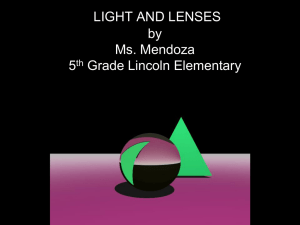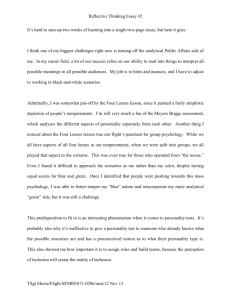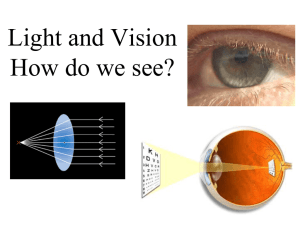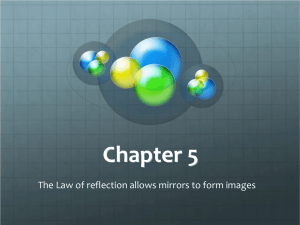Lesson #6: Optics and the Eye - Center for Learning in Action
advertisement
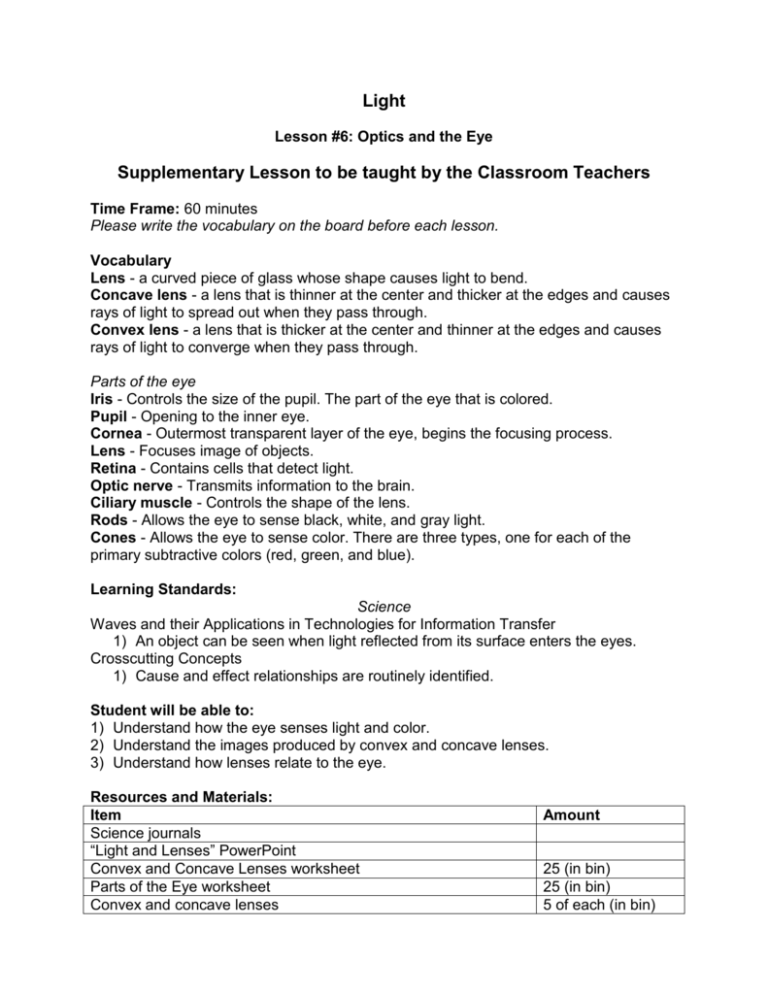
Light Lesson #6: Optics and the Eye Supplementary Lesson to be taught by the Classroom Teachers Time Frame: 60 minutes Please write the vocabulary on the board before each lesson. Vocabulary Lens - a curved piece of glass whose shape causes light to bend. Concave lens - a lens that is thinner at the center and thicker at the edges and causes rays of light to spread out when they pass through. Convex lens - a lens that is thicker at the center and thinner at the edges and causes rays of light to converge when they pass through. Parts of the eye Iris - Controls the size of the pupil. The part of the eye that is colored. Pupil - Opening to the inner eye. Cornea - Outermost transparent layer of the eye, begins the focusing process. Lens - Focuses image of objects. Retina - Contains cells that detect light. Optic nerve - Transmits information to the brain. Ciliary muscle - Controls the shape of the lens. Rods - Allows the eye to sense black, white, and gray light. Cones - Allows the eye to sense color. There are three types, one for each of the primary subtractive colors (red, green, and blue). Learning Standards: Science Waves and their Applications in Technologies for Information Transfer 1) An object can be seen when light reflected from its surface enters the eyes. Crosscutting Concepts 1) Cause and effect relationships are routinely identified. Student will be able to: 1) Understand how the eye senses light and color. 2) Understand the images produced by convex and concave lenses. 3) Understand how lenses relate to the eye. Resources and Materials: Item Science journals “Light and Lenses” PowerPoint Convex and Concave Lenses worksheet Parts of the Eye worksheet Convex and concave lenses Amount 25 (in bin) 25 (in bin) 5 of each (in bin) Focus Activity: Students should explore the effects of two types of lenses, convex lenses and concave lenses. Ask students to observe differences between the two lenses and write and draw their observations in their science journals. If necessary, use questions to spark investigation: when you look through the lens, does an image look bigger or smaller? Is the image clear? Does the image change color or shape? Introduction: Explain that lenses cause light to bend, or refract. The curved surface of the glass on the convex lens bends light such that it causes the light rays originating from an object to converge on a focal point. The curved surface of the glass on the concave lens bends light such that it causes the light rays originating from an object to diverge. We perceive the size of an object by automatically tracing backwards from the angle of the light rays entering our eyes. Thus, in the case of convex lenses, the convergence of light rays passing through convex lenses to our eyes makes objects appear magnified. The opposite happens for concave lenses. The divergence of light rays passing through concave lens to our eyes makes objects appear smaller than they actually are. (See the visual representation below. Please utilize the main ideas from this image to describe this phenomenon to the students.) Activity: 1) Do the Convex and Concave Lenses worksheet. Can you think of any examples of convex and concave lenses? (Example of convex lenses: magnifying glasses, example of concave lenses: car mirrors) What might each type of lens be useful for? (Convex lenses are useful for magnifying things, concave lenses are useful for seeing a big area) 2) Go through the “Light and Lenses” PowerPoint slides about the lenses in the eye with the class. You can find a link for the PowerPoint Presentation on the Center for Learning in Action website at this web address: http://learning-inaction.williams.edu/opportunities/elementary-outreach/science-lessons/4thgrade-waves-unit/ under Light unit Lesson 6. 3) Do the Parts of the Eye worksheet. What are rods and cones? How are they involved in vision? Closure: Your body has some "built-in" devices to protect your eyes such as: ● Bony sockets: your eyes are located in bony sockets to protect them from getting hit. ● Eyebrows: your eyebrows are used to keep the light out. ● Eyelids: your eyelids can close to keep small objects out of your eyes. ● Eyelashes: eyelashes also keep small objects out of your eyes. ● Tears: tears keep your eyes moist and work to wash small objects out of your eyes. In addition, it is very important to practice eye safety! Here are some tips to keep your eyes healthy: ● Have your eyes examined regularly, and never wear glasses that have not been prescribed to you by a doctor. ● Never look directly at the sun. ● Do not share eye makeup with anyone. ● Wear proper eye protection when you play sports. ● Use good lighting to avoid tiring your eyes when reading, writing or cruising the Internet. ● Tell your parents, school nurse or teachers if your eyes are bothering you. Assessment: Science journals, worksheets, participation Name:_________________________________________ Date:_________________ Convex and Concave Lenses Draw the light rays from the top and bottom of each of these objects going through either a convex or concave lens. Don’t forget to add a picture of the result on the right! Write the type of lens in each set under the lens. Example: 1) Convex Lens ______________________ 2) ______________________ 3) ______________________ 4) ______________________ 5) ______________________ Name:_______________________________________________ Date:___________________ How the Eyes Work: Parts of the Eye Below is a drawing of the eye with some of the more important parts numbered. Write the names of the parts of the eye and their functions in the proper boxes. The word bank is there to help you. Number Part Name 1 2 3 4 5 6 7 . . . . . . . Function . . . . . . . Word Bank Part Names Lens Retina Ciliary Muscle Optic Nerve Pupil Cornea Iris Functions Contains cells that detect light Opening to the inner eye, place where light enters the eye Controls the size of the pupil Focuses image of object Controls shape of lens Transmits information to brain Outermost transparent layer of eye, begins focusing process
